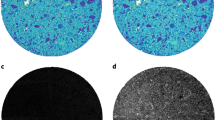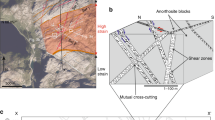Abstract
Non-impulsive seismic radiation or ‘tremor’ has long been observed at volcanoes1 and more recently around subduction zones2. Although the number of observations of non-volcanic tremor is steadily increasing, the causative mechanism remains unclear. Some have attributed non-volcanic tremor to the movement of fluids2,3,4,5,6, while its coincidence with geodetically observed slow-slip events at regular intervals7,8 has led others to consider slip on the plate interface as its cause7,8,9,10,11,12,13,14. Low-frequency earthquakes in Japan, which are believed to make up at least part of non-volcanic tremor9, have focal mechanisms10 and locations11 that are consistent with tremor being generated by shear slip on the subduction interface. In Cascadia, however, tremor locations appear to be more distributed in depth than in Japan3,4, making them harder to reconcile with a plate interface shear-slip model. Here we identify bursts of tremor that radiated from the Cascadia subduction zone near Vancouver Island, Canada, during the strongest shaking from the moment magnitude Mw = 7.8, 2002 Denali, Alaska, earthquake. Tremor occurs when the Love wave displacements are to the southwest (the direction of plate convergence of the overriding plate), implying that the Love waves trigger the tremor. We show that these displacements correspond to shear stresses of approximately 40 kPa on the plate interface, which suggests that the effective stress on the plate interface is very low. These observations indicate that tremor and possibly slow slip can be instantaneously induced by shear stress increases on the subduction interface—effectively a frictional failure response to the driving stress.
This is a preview of subscription content, access via your institution
Access options
Subscribe to this journal
Receive 51 print issues and online access
$199.00 per year
only $3.90 per issue
Buy this article
- Purchase on Springer Link
- Instant access to full article PDF
Prices may be subject to local taxes which are calculated during checkout



Similar content being viewed by others
References
McNutt, S. R. Volcanic seismology. Annu. Rev. Earth Planet. Sci. 33, 461–491 (2005)
Obara, K. Nonvolcanic deep tremor associated with subduction in southwest Japan. Science 296, 1679–1681 (2002)
Kao, H. et al. A wide depth distribution of seismic tremors along the northern Cascadia margin. Nature 436, 841–844 (2005)
McCausland, W., Malone, S. & Johnson, D. Temporal and spatial occurrence of deep non-volcanic tremor: From Washington to northern California. Geophys. Res. Lett. 32 L24311 doi: 10.1029/2005GL024349 (2005)
Katsumata, A. & Kamaya, N. Low-frequency continuous tremor around the Moho discontinuity away from volcanoes in the southwest Japan. Geophys. Res. Lett. 30 1020 doi: 10.1029/2002GL015981 (2003)
Seno, T. & Yamasaki, T. Low-frequency tremors, intraslab and interplate earthquakes in Southwest Japan—from a viewpoint of slab dehydration. Geophys. Res. Lett. 30 2171 doi: 10.1029/2003GL018349 (2003)
Rogers, G. & Dragert, H. Episodic tremor and slip on the Cascadia subduction zone: The chatter of silent slip. Science 300, 1942–1943 (2003)
Obara, K., Hirose, H., Yamamizu, F. & Kasahara, K. Episodic slow slip events accompanied by non-volcanic tremors in southwest Japan subduction zone. Geophys. Res. Lett. 31 L26302 doi: 10.1029/2004GL020848 (2004)
Shelly, D. R., Beroza, G. C. & Ide, S. Non-volcanic tremor and low frequency earthquake swarms. Nature 446, 305–307 (2007)
Ide, S., Shelly, D. R. & Beroza, G. C. Mechanism of deep low frequency earthquakes: Further evidence that deep non-volcanic tremor is generated by shear slip on the plate interface. Geophys. Res. Lett. 34 L03308 doi: 10.1029/2006GL028890 (2007)
Shelly, D. R., Beroza, G. C., Ide, S. & Nakamula, S. Low-frequency earthquakes in Shikoku, Japan, and their relationship to episodic tremor and slip. Nature 442, 188–191 (2006)
Ide, S., Beroza, G. C., Shelly, D. R. & Uchide, T. A scaling law for slow earthquakes. Nature 447, 76–79 (2007)
Obara, K. & Hirose, H. Non-volcanic deep low-frequency tremors accompanying slow slips in the southwest Japan subduction zone. Tectonophysics 417, 33–51 (2006)
Royle, G. T., Calvert, A. J. & Kao, H. Observations of non-volcanic tremor during the northern Cascadia slow-slip event in February 2002. Geophys. Res. Lett. 33 L18313 doi: 10.1029/2006GL027316 (2006)
Obara, K. Time sequence of deep low-frequency tremors in the Southwest Japan Subduction Zone: Triggering phenomena and periodic activity. [in Japanese] Chigaku Zasshi (J.. Geogr.) 112, 837–849 (2003)
Miyazawa, M. & Mori, J. Detection of triggered deep low-frequency events from the 2003 Tokachi-oki earthquake. Geophys. Res. Lett. 32 L10307 doi: 10.1029/2005GL022539 (2005)
Miyazawa, M. & Mori, J. Evidence suggesting fluid flow beneath Japan due to periodic seismic triggering from the 2004 Sumatra-Andaman earthquake. Geophys. Res. Lett. 33 L05303 doi: 10.129/2005GL025087 (2006)
Miyazawa, M. & Brodsky, E. E. Fluid related deep low-frequency earthquakes resonant with the Rayleigh waves from the 2004 Sumatra-Andaman earthquake. J. Geophys. Res. (submitted)
Gomberg, J., Bodin, P., Larson, K. & Dragert, H. Earthquake nucleation by transient deformations caused by the M = 7.9 Denali, Alaska, earthquake. Nature 427, 621–624 (2004)
Tsuboi, S., Komatitsch, D., Ji, C. & Tromp, J. Broadband modeling of the 2002 Denali, Alaska Mw 7.9 earthquake on the Earth Simulator. Phys. Earth Planet. Inter. 139, 305–313 (2003)
Mazzotti, S. et al. Current tectonics of northern Cascadia from a decade of GPS measurements. J. Geophys. Res. 108 2554 doi: 10.1029/2003JB002653 (2003)
Kao, H., Shan, S.-J., Rogers, G. & Dragert, H. Migration characteristics of seismic tremors in the northern Cascadia margin. Geophys. Res. Lett. 34 L03304 doi: 10.1029/2006GL028430 (2007)
Brodsky, E. E. & Prejean, S. G. New constraints on mechanisms of remotely triggered seismicity at Long Valley Caldera. J. Geophys. Res. 110 B04302 doi: 10.1029/2004JB003211 (2005)
Gomberg, J., Reasenberg, P. A., Bodin, P. & Harris, R. A. Earthquake triggering by seismic waves following the Landers and Hector Mine earthquakes. Nature 411, 462–466 (2001)
Liu, Y. & Rice, J. R. Spontaneous and triggered aseismic deformation transients in a subduction fault model. J. Geophys. Res. (submitted)
Dragert, H., Wang, K. & Rogers, G. Geodetic and seismic signatures of episodic tremor and slip in the northern Cascadia subduction zone. Earth Planets Space 56, 1143–1150 (2004)
Acknowledgements
H. Kao, G. Rogers and H. Dragert provided comments and data that assisted with the tremor source location. Comments from W. McCausland, N. Beeler and H. Houston improved this manuscript. The data used in this study come from the Canadian National Seismograph Network and are distributed freely by The Geological Survey of Canada. This work was inspired by conversations with T. Pratt.
Author Contributions J.L.R. and J.E.V. found and identified the tremor, J.G. and P.B. computed the fault plane stresses, K.C.C. located the tremor source, and J.L.R. performed the spectral analysis. J.L.R., with the help of all, integrated the results.
Author information
Authors and Affiliations
Corresponding author
Ethics declarations
Competing interests
Reprints and permissions information is available at www.nature.com/reprints. The authors declare no competing financial interests.
Supplementary information
Supplementary Figures
This file contains Supplementary Figures S1-S5 with Legends (PDF 1507 kb)
Rights and permissions
About this article
Cite this article
Rubinstein, J., Vidale, J., Gomberg, J. et al. Non-volcanic tremor driven by large transient shear stresses. Nature 448, 579–582 (2007). https://doi.org/10.1038/nature06017
Received:
Accepted:
Issue Date:
DOI: https://doi.org/10.1038/nature06017
This article is cited by
-
Tremor along the Dead Sea Transform remotely triggered by the 2023 MW7.6 Kahramanmaraş earthquake
Communications Earth & Environment (2024)
-
A review on slow earthquakes in the Japan Trench
Progress in Earth and Planetary Science (2023)
-
The Qp attenuation structure of the Koyna-Warna region, Maharashtra India, and its correlation to seismicity
Acta Geophysica (2023)
-
Low-frequency earthquakes along the Ryukyu Islands triggered by teleseismic earthquakes
Earth, Planets and Space (2021)
-
Tectonic tremors in the Northern Mexican subduction zone remotely triggered by the 2017 Mw8.2 Tehuantepec earthquake
Earth, Planets and Space (2021)
Comments
By submitting a comment you agree to abide by our Terms and Community Guidelines. If you find something abusive or that does not comply with our terms or guidelines please flag it as inappropriate.



